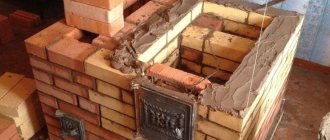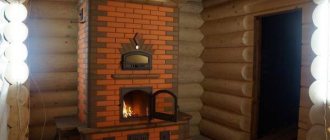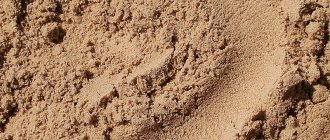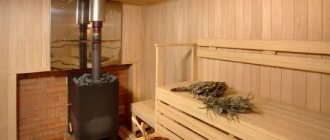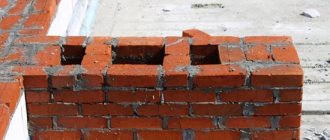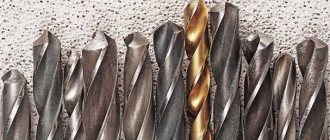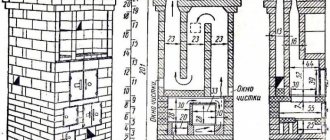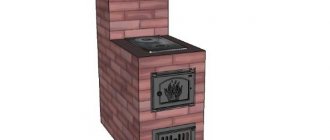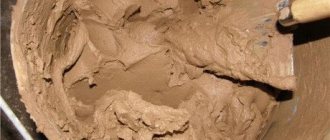Grouting brickwork joints
Grouting is the application of a special additional layer to the surface between the bricks after they are laid. This material is used for vertical or horizontal wall laying, after the excess mixture has been removed from the joints of each brick, but small irregularities remain. Grouting, or as it is also called jointing, is used precisely for such purposes. The brick laying turns out beautiful and even. The layer that will protect from moisture has increased tightness and strength. As a result, the service life of the structure increases.
They try to carry out the jointing immediately after the construction has been completed. Of course, there are also cases when this work is done several years later. In this case, the wall has already absorbed a large amount of moisture and is gradually collapsing.
Grouting is done only on those walls on which plaster or cladding will not be applied in the future.
Jointing for brickwork
When erecting a brick building, do not forget about the final stage of construction, such as grouting the joints between materials. This will help create an individual aesthetic appearance and protect the walls from moisture penetration and precipitation.
The finishing of the building may vary depending on the type of work chosen, but the most popular and affordable is jointing for brickwork. The most common standard type of brickwork is one in which there are vertical and horizontal joints. Grouting the joint with a special solution involves joining the entire masonry into a single and complete canvas, protected from the penetration of water, moisture, wind, and small particles.
After the mortar is placed in the joints and the surface of the brick is cleared of its excess, you can proceed to jointing the joints with your own hands. The jointing procedure involves grouting the joints. This is the stage of work that allows you to increase the tightness of the masonry, make the facades more beautiful and attractive, and the walls resistant to aggressive environmental influences. Only high-quality grouting of bricks will help extend the service life of the building itself.
On video: Joining brickwork joints
Why do they do it?
Experts call the procedure for processing the seams of brickwork jointing. The grouting process is the application of an additional layer to cement joints. Performed if the walls are not planned to be subjected to additional cladding work. The jointing has a decorative function and also has practical characteristics.
Decorative properties are as follows:
- highlighting the texture of lines and brick patterns;
- combining vertical and horizontal lines;
- strict and clear appearance of the facade.
Practical properties include:
- increasing the level of sound insulation;
- protection from excessive moisture;
- improved heat retention;
- increased service life of the building;
- tightness.
Brick joint grout seals all cracks and covers the cement layer.
This procedure is not able to eliminate errors in the form of uneven masonry, excess cement, curvature, or stains on the wall.
Some buildings are operated without jointing, so it is necessary to note the main purpose of this procedure. As mentioned above, in this way it will be possible to increase the aesthetic perception at the first glance at the building. By resorting to this method of decoration, you can mask differences in color that may arise if the solution was mixed gradually.
Grouting for external use helps prevent the destruction of the cement mixture, thus extending the life of the building and postponing the need for major repairs for a long time. This result can be achieved by protecting the joints from excess moisture, which has a destructive effect on the cement mortar.
Benefits of grouting
- Improving the appearance of the building facade. The grout has a rich color palette. Using contrasting colors, you can emphasize the harmony of the masonry.
- Protection from moisture not only the seams, but also the walls of the house, which increases their service life.
- The sound and heat insulation properties of floors are significantly increased.
It is not always possible to see buildings with similar decoration. If the masonry is subsequently to be plastered or faced, grouting is not required. Advice. When subsequently decorating the seams for masonry, you must use only intact and flawless material, and the seams must be the same in thickness. There are craftsmen who make horizontal seams somewhat thicker than vertical ones. This is a design decision.
The feasibility of using jointing
In construction, grout has decorative and practical significance. The first option has the following properties:
- Emphasize the correctness of the lines.
- A new color is added to the created design.
- The drawing turns out clear and bright.
- The appearance of the structure is improved.
- The masonry is more neat and expressive.
- Grout combines horizontal and vertical lines.
Important! Beginning craftsmen need to remember that processing seams does not eliminate surface defects: excess cement, curvature of walls, fragments of hardened composition on bricks.
High-quality jointing of brickwork
Practical value:
- Protection of cement composition from the destructive effects of moisture.
- Increased sound insulation characteristics.
- Significant extension of the protective properties of the cement base.
- Strengthening the thermal insulation of the building.
- Increasing the strength of brick masonry.
- Strengthening the density of joints.
- Additional tightness.
- Hiding small cracks and crevices.
You can seal the holes if the masonry is done carefully. If there are decorative seams, use whole bricks, without flaws. It is necessary to ensure that the solution has the same thickness on all parts of the surface.
According to accepted SNiP standards, the width of the horizontal and vertical space left should not exceed 15 mm. Grout is used for decorative, building material, gypsum tiles. A special composition is also used for facade panels and natural stone.
Final processing of a brick wall
...apply impregnate
After two or three days, when the grout has dried, the wall needs to be treated with an impregnation agent, which will protect it from contamination and make it easier to care for the surface (there are special preparations on sale for impregnating exposed brickwork). The impregnate is applied with a brush or sponge.
As a result of this treatment, the wall will not absorb water and will become resistant to fats and household chemicals.
Grouting and jointing mixtures are building materials designed to bring tiling work to perfection.
They perform both aesthetic and practical functions. Types of grouting compounds Modern grouting for joints can have a cement and epoxy base. Products of the first group are characterized by lower cost, which explains their wide popularity. When using these materials, you don’t have to save money - the joints should be filled in excess so that no cracks or crevices remain. If desired, a cement-based grouting mixture can be used with your own hands, without turning to specialists.
To do this, you need to prepare a solution of the required consistency, and the work itself should be performed with goggles and a respirator, which will protect the body from harmful volatile compounds. Epoxy materials are sold in ready-to-use form. They are highly flexible and therefore easy to apply. The compositions will be an excellent solution for use by beginners.
Their main drawback is their high cost compared to cement-based analogues. Selecting grout for difficult operating conditions You should be especially careful when choosing grout for filling joints that will be installed in the bathroom. This is a special room that faces sudden temperature changes, as well as high humidity. The best solution would be a grout containing epoxy resins.
This material does not absorb moisture and has high adhesion. Therefore, it can be used when tiling, which is laid on the walls and bottom of swimming pools, when finishing facades and lining the interiors of public premises. Epoxy grouts have a high hardening speed, so you need to work with them quickly. It is noteworthy that the material retains its original color for decades.
It is sold in a ready-to-use form. How to choose a grout mixture There are recommendations from experts who will help you choose the optimal solution for grouting joints. For example, for a floor it is preferable to choose a material with a darker shade than tiles. It is better not to use light colors - over time, due to exposure to dirt, they will darken and lose their aesthetic appeal. It is preferable to purchase grout from well-known brands.
They are distinguished not only by their excellent appearance, but also by their excellent performance parameters. For example, they may contain substances that prevent the formation of fungus and mold. Our catalog contains products from the following brands:
St. Petersburg, Piskarevsky pr., 150, bldg. 2, letter N
Clinker tiles are an expensive and very beautiful material that requires careful laying and sealing of joints with special compounds. Thanks to professional grouting, the seam becomes neat, and the cladding will become not only a decoration of the building, but a protective barrier from bad weather, mold and destruction.
It provides several important advantages:
improving the decorative qualities of masonry.
The grout is available in various colors, which allows you to choose the most suitable shade that will highlight the beauty of the color and texture of the clinker. In addition, successful grouting allows you to hide the imperfections of the masonry and make its geometry close to ideal; tile protection. It resists chipping on the edges well;
strengthening the cladding. The composition for sealing joints strengthens the masonry, makes it more resistant to various external influences, prevents moisture from getting under the tiles, thereby increasing the frost resistance of the facade and preventing the appearance of mold.
The gray adhesive composition spoils the appearance of the facing brick, and moisture getting into the seam between the tiles and freezing can even lead to rapid destruction of the cladding. Grouting for clinker tiles is designed to avoid all these negative consequences.
Possible options
There are several options for how to do the jointing. The visual effect that the wall will receive depends on the chosen method.
When working on the filling, you need to follow the sequence, starting first with the vertical seams, and then with the horizontal ones.
Special attention is not paid to the thickness of the seams. The indicator can vary from ten to fifteen millimeters for horizontal seams, and from eight to twelve for vertical ones. But most often you can find thin seams, four millimeters thick. This decision was driven by the desire to save on cement mixture. Also, the thickness of the seams depends on the worker’s approach to performing the procedure and climatic influence.
The process of finishing the seams is important regardless of the thickness, because a clear pattern will not only decorate the walls, but also increase the performance characteristics of the building. What methods exist to highlight brick seams?
Flush
This option is the easiest to implement. You can do jointing in this way even without a special tool. Filling mortar that protrudes beyond the brick or gets on it is removed with a trowel. After the main process, the seam is processed using a stiff brush.
Concave
This method requires a special narrow spatula. This small tool will fill the seams. For ease of working on all lines, the spatula should not be long. The cement mortar is removed from the masonry, as in the previous version, after which they go along the seam with a jointing tool. The grout solution is applied inside in the same way.
Convex
To work on jointing with a convex effect, you need an arched spatula. The tool is applied to the seam with the arc part facing outwards, the resulting space must be filled with mortar. Afterwards, the spatula is moved further to the untreated area and the construction mixture continues to be applied.
Undercut or flush
This method is considered the most accessible and is most often used for making masonry joints.
The main idea is that the mortar protruding from the masonry is trimmed with a trowel, after which the seam areas are additionally treated with a hard-bristled brush. Using this method, the joining areas are given ideal smoothness and aesthetics.
Rectangular
This option is more difficult to work with than the previous ones. First, you need to remove five millimeters of cement from the seam, even if it has already dried. After this, the gaps are filled with grout mixture. This design looks interesting, but experts do not recommend using this method for facade decoration due to poor drainage.
Beveled
This method is suitable for buildings that are being built in harsh climates. In this option, the mortar between the seams is not cut straight, but at an angle. The cutting angle should be sharp, 3-5 millimeters.
Advantages and disadvantages
Jointing masonry joints has the following advantages:
- this finishing option requires almost no additional building materials;
- the service life of brick walls increases;
- the need for cosmetic repairs is reduced;
- protection of the surface from natural factors is created;
- the work is carried out independently, the involvement of professional specialists is not required;
- the aesthetic appeal of the walls improves;
- masonry mixture is saved.
Unfortunately, there are also certain negative aspects:
- with some jointing methods there is a slight decrease in the thermal insulation properties of the walls;
- walls made of silicate stone require special attention when jointing - it is difficult to remove cement stains from the surface of the facing material;
- the work is painstaking. The slightest mistake spoils the entire appearance of the surface.
Types of jointing and their main characteristics
In fact, there are several types of seam stitching. Previously, only two options were considered: concave and convex. In practice, you can find many more of them. These are:
- To the pruning.
- Pustoshovka.
- Simply connected and doubly connected concave.
- Doubly connected convex.
The most popular options are worth considering:
1. Flush - the most common type of jointing. The procedure consists of the following steps: the remaining mortar is cut off from the surface of the wall using a construction trowel, then the gaps between the bricks are processed with a brush, resulting in smooth and clear white seams.
2. Recessed rectangular - this type is used when creating decorative finishes. This variety requires significant labor costs and is more suitable for treating walls indoors, since such jointing cannot withstand constant exposure to precipitation and atmospheric phenomena. The processing technology is as follows: in the seams at a depth of 5 mm, you need to remove the mortar, then compact the new mixture, smooth it using construction tool.
3. Concave – another common option, which involves the use of a special “jointing” tool. Excess mortar is cut off, the seams are processed with semicircular jointing.
4. Beveled - grout is able to withstand harsh climatic conditions, therefore it is common in the relevant regions. To process joints you need to use a carefully sharpened trowel. Grouting is carried out using the following technology: excess mortar is cut off with this tool, located at an acute angle, with a recess of 3-4 mm.
Required tools and materials
Before you start jointing the brickwork, you should prepare the following tools and materials:
- brushes - with hard bristles and wire;
- hammer;
- a stitching tool, which can be used as a finished factory product or home-made devices;
- a flat wooden strip with a length of at least 1 m;
- roller or soft brush to wet the surface.
If you plan to restore an old wall, you will additionally need:
- a hammer drill, a wooden wedge or a narrow chisel with the width of the working part slightly less than the thickness of the seam;
- a special mixer designed for mixing the solution;
- container for preparing cement-sand mixture;
- trowel or trowel.
In addition, you will need cement, sand, lime and water in the required quantities.
What is needed for grouting
First, you should choose a mixture that matches the color scheme of the brick and its structure. Basically, brick grout is purchased in parallel with its purchase. The more the color palette of materials matches each other, the more harmonious the styling will look.
Tools for grouting brickwork joints.
Moreover, you need to purchase the following tools and materials:
- perforator;
- an attachment for a rotary hammer in the form of a pinwheel;
- spatulas;
- mixing container;
- metal sieve;
- the device is in the form of an arc, it is a curved plate with a handle, the width of which is equal to the width of the seam between the brick;
- sand;
- cement;
- water;
- dry composition for brickwork joints.
It is best to do the treatment when the masonry mortar has already dried.
If the store fails to select the mixture of the required color, the masonry surface should be treated with a traditional sand-cement mortar.
The end result is joints that have a light gray or dark gray color, which is suitable for bricks of virtually any color.
to come back to the beginning
Preparatory activities
Joining can be carried out immediately after laying the brick or after erecting the walls. In the first case, the mason brings the masonry into proper shape after several rows have been completed and the mortar begins to set.
In the second case, when laying, the master leaves the outer part of the seam empty for subsequent filling with jointing mixture, and they begin refining the wall after a certain time has passed, necessary for complete shrinkage of the masonry.
Before restoring old masonry, it is necessary to remove the mortar from the joints to a depth of 15 mm and clean the wall from dust and dirt
Preparing the masonry is carried out in the following sequence:
- If it is necessary to update the cladding of an old wall, parts of the old jointing are removed from the seams to a depth of 10 - 15 mm. To avoid damaging the bricks, it is better to use a narrow wooden wedge and a hammer. If it is not possible to knock off parts of the frozen solution, use a chisel;
- Use improvised means to remove dust and dirt from the walls of the building;
- The seams are cleaned using a stiff brush or a high-pressure apparatus. This work should be carried out very carefully, since dirt and dust particles interfere with the adhesion of the jointing solution;
- After cleaning, the seams are moistened using a roller or soft brush and a bucket of water.
The preparation of the cement-sand mixture begins only after the surface has been completely prepared for the next stage, at which the jointing solution is prepared.
You can make the jointing mixture yourself or use a ready-made factory-made composition, which is sold dry. and in wet form. Since the solution is used for decorative purposes, concrete dyes can be added to it. A concrete mixer will speed up the process of preparing the jointing mixture
If you prefer to do everything yourself, then to prepare the optimal mixture, take lime, sand and cement in a ratio of 1:10:1 and mix with water until the consistency of very thick sour cream is obtained. Remember that the composition remains mobile for up to 1.5–2 hours, so mix only the amount that you can use during this time.
If the mixture you receive is too liquid, you can remove excess moisture from it by placing dry red brick in a container with the solution for 1 - 2 minutes.
For large volumes of work and the presence of assistants, a concrete mixer will help speed up the process.
How to use?
To fill the seams with your own hands, you will need a set of tools, including a rubber and wooden spatula, and a special device for achieving even filling of gaps - a grout bag. It is useful for aesthetically and quickly processing red decorative bricks and clinker tiles. First, you should dilute the grout and prepare the surface where it will be applied. Then carefully apply the mixture and compact it into the joint gap between the bricks. It is recommended to wipe off the excess immediately, without waiting for it to dry.
Each mixture has its own instructions for use, however, on average, dry compositions are dissolved in a proportion of 1 kg per 200 ml of water. The mass must be homogeneous, so it should be mixed well manually or mechanically. The grout has its best characteristics in the first three hours, then it begins to thicken and loses its elasticity. It is better not to use stale mortar; this can lead to loss of waterproofing of the joints due to microcracks subsequently forming when the mixture dries.
Safety precautions
You should not grout in hot weather, because the mortar mixture dries out much faster. Craftsmen recommend waiting out rainy weather so that the solution does not absorb a lot of moisture.
Carrying out such work requires the use of protective equipment - helmet, goggles, gloves, overalls and a respirator. Before working on scaffolding, you should study the safety requirements for high-rise repairs.
It is prohibited to hang yourself on a wall or lean on freshly laid brickwork, work on random supports, or leave tools unattended.
Proper professional grouting
Scheme of jointing in brickwork.
After all stages of the masonry work are completed, it is necessary to seal the seams in the brick wall. This is the last, final stage. You should know what is required for grouting joints in brickwork:
- putty knife;
- perforator;
- arcuate device;
- attachment for a hammer drill (spinner);
- trough;
- sieve.
For such work, the following building materials will be required:
- cement;
- sand;
- ready-made dry mixture for grouting;
- water.
Jointing technology during construction
In this case, the seams are processed immediately after laying several brick lines. The starting point for work is the beginning of hardening of the composition. The composition itself must retain its plasticity.
It is important to follow the following sequence:
- When laying this material, the entire composition that protrudes outwards is cut off flush with the laid masonry. Such pruning significantly increases the rate of jointing. An example of this is shown in the figure below:
Pruning
- The wall surface is thoroughly cleaned. The working tool is a stiff fleecy brush.
- Sewing vertical seams. The tool moves from top to bottom and is pressed into the masonry. Air is removed from the composition by pressure. The density and strength of the composition develops. First of all, short seams are unstitched vertically.
- To make the seams horizontally even, a wooden strip is attached to their underside. You should lean on it and guide it along the masonry line. Uniform pressure here will create a pleasant aesthetic finish.
- Filling seams vertically. Then - horizontally. Movement on the working surface: from top to bottom.
- When the composition has completely set, the elements of the jointing mixture are removed from the wall. A broom or brush is used here.
Methods of carrying out work
Grouting can be done in two ways, in which the seams will have either a convex or sunken appearance. When performing a processing method called sunken, you will need a small spatula, with which both vertical and horizontal seams are simultaneously filled with the mixture. When the grout is applied, the tool with the arc is turned inward and the excess mortar is removed.
In order to perform convex grouting, an arc-shaped tool is applied to the gap between the bricks with an arc outward and the space is filled with mortar. When one of the seams is filled, the tool is pulled further. Thus, all horizontal seams are filled. When the mixture dries, you can do convex grouting of the vertical joints. All excess mixture is wiped off the surface of the bricks with a damp cloth.
As can be seen from the information presented, grouting the joints of brickwork can be successfully done with your own hands. A properly prepared solution will last a long time and reliably, giving brick walls an aesthetically attractive appearance and preventing moisture from entering the masonry.
Grouting old masonry joints
Grouting of joints can be done not only on fresh masonry. Using this method, you can improve the appearance of an old brick building. This is especially true if the mortar in the gaps has already begun to deteriorate, causing the thermal insulation of the entire structure to deteriorate.
Old brickwork
If grouting is done on old brickwork, then you must first remove part of the old mortar (about 1-2 cm). This is done using a chisel and a hammer. You can also wash off the remains of the old mortar using a special device that blasts the masonry with a powerful stream of water (for example, a mini high-pressure washer).
Types of grout for decorative bricks
To fill the gaps between different building materials, there are several main types of grout mixtures and technologies. Both the color of the surface, the space between which needs to be filled, and the thickness of the depressions play a role. Ready-made mixtures are sold in construction markets: black, red, white and colored. At home, you can achieve any shade by mixing. Grouts are most often used in construction for materials such as:
- gypsum tiles;
- decorative and building red brick;
- paving stones;
- facing tiles;
- wild stone or its imitation.
Typical grouting of decorative brick joints can be done either with a special waterproofing solution in rooms where there is moisture or outdoors, or with paint. For paving stones, concrete-containing mixtures are used, the additional purpose of which is to firmly fix the bricks. Tile, gypsum, and ceramic slabs are rubbed with polymer and concrete mixtures, sometimes with the addition of liquid insulating latex and polymer additives. The color of the joints is matched to the tiles. You can rub the seams with plaster, but the procedure must be performed with great precision, since the material hardens quickly and will be difficult to clean off. If the grout of ceramic or gypsum tiles turns out sloppy, it is better to immediately wash it off with hot water and redo it.
Brick grout is the finishing touch that allows you to isolate joint gaps and aesthetically decorate the walls.
Main stages of grouting
The seams are processed after finishing the bricklaying. The process is monotonous and it takes a lot of time to solve the problem. A novice master will be able to do the grouting himself. For inexperienced masons, experts have created step-by-step instructions:
- Prepare the surface. You need to clean the masonry and seams with a regular stiff brush.
- Rinse the wall with clean water. The most convenient way to do this is with a pressure hose. Wet the wall surface. This is necessary so that the brick does not draw moisture out of the mortar, and cracks do not form during natural drying.
- After preparation, prepare the solution according to the instructions.
- Use a large spatula to scoop up the working mixture, gradually applying it to the seam. It is better to use narrow jointing. To do this, craftsmen carefully embroider the joints located horizontally.
- To remove accumulated air and achieve maximum density, the tool is pressed into the gap.
- Vertical joints are filled with cement-sand mortar according to the standard pattern. The prepared composition is held in the palm of your hand.
- The entire area is cleaned with a brush.
- At the final stage, the type of jointing is formed. This procedure begins immediately after the solution has set.
Important! Experts recommend determining the amount of solution in advance in order to have time to use it before it hardens.
Surface preparation
Shaping the finish
Grouting stages
Grouting external facial seams and working with external facades allows the masonry to acquire not only an aesthetic appearance, but also protects it from the penetration of precipitation and the accumulation of moisture inside. Main features of grouting:
- If the selected shade of grout does not match the tone of the brick, it is necessary to carry out the procedure using cement-sand mortar. If the grout mixture needs to be given a certain shade, then a dry substance containing color should be used. You can even treat the spaces between the bricks with black and white grout.
- Then the mixture is independently prepared by sifting and cleaning the sand from impurities, adding cement, and diluting with water. It is imperative to knead with a special tool using a hammer drill.
- To prepare a colored solution, you must use a ready-made commercial mixture and mix according to the instructions described above.
- If clean masonry is being carried out, then in this case it is strictly not recommended to leave excess mixture on the bricks. It is necessary to use such an application technology so that most of the solution gets on the inside of the wall and a minimum amount on the front. This is done so that after the brick shrinks, it is not visible how the mortar diverges and the external seams remain unfilled.
- You can also choose the appropriate type of grout - convex or sunken. Both are performed using a special tool in the form of an arc, which allows you to create the desired effect. First, horizontal seams are processed, after they harden, vertical seams are processed when choosing a convex grout. If sunken, all seams can be processed simultaneously.
Joint jointing of brickwork
Grouting the joints of brickwork is considered the finishing action of wall finishing, giving it a finished look. This action is aimed at creating an aesthetically pleasing surface.
It is necessary in most cases, since during masonry it is impossible to avoid the appearance of errors that negatively affect visual perception.
Currently, there are many different materials used for these purposes, which differ significantly from each other not only in their final appearance, but also in the chemical composition of the components.
Main goals
The grout will protect the masonry from wind and sun
If everyone knows the reason why it is necessary to grout the seams between the tiles, to give a finished appearance, then for brickwork you can give several understandable motives.
Some professionals call this action jointing, and the meaning does not change. Compulsory implementation is required for the following reasons:
- The grout composition protects the walls from the harmful effects of the environment (wind, ultraviolet rays, temperature changes, precipitation). The cement mortar deteriorates over time and the integrity of the surface is compromised. It plays the role of waterproofing; the use of high-quality material guarantees that in a few years the walls will not crack under their influence.
- There is a specific property for the seams of brickwork that protects it from blowing by strong winds. The use of grout mixtures allows them to be protected from the penetration of cold air through the micropores of the cement mortar.
Varieties of material and methods
Epoxy-based compounds are used for interior finishing.
Masonry joints must be treated with special compounds. Several different types of grout can be used for these purposes. However, in Russia, with frosty winters, only 2 types are widely used:
- cement-based mixture;
- composition made from epoxy resin.
The first is mainly used for treating external walls, the second - internal, as it is much easier to wash and clean. The color of the composition is determined depending on the wishes of the owner and is achieved by mixing with the color scheme.
In addition, you can use chemical components that will prevent the formation of fungus and mold, as well as increasing resistance to sudden changes in temperature conditions.
The appearance of the wall will depend on the grouting method chosen. The final result will depend on what tool will be used to complete the work. While some of the grout joints can be applied using a spatula, more complex compositions will require a special device.
To a greater extent, seaming is done in the following ways:
- Flush, in this case the composition is placed inside the seam, and the excess is removed with a spatula. After this, the brick is cleaned with a brush.
- A convex seam is applied using a similar method, however, the excess is not removed with a spatula, but, on the contrary, a special arc-shaped device is passed along it, after which a neat mark is formed. Thus, horizontal masonry is processed; vertical seams must be made after the first ones have partially hardened.
Why grout joints in brickwork?
When laying the external brick walls of a house, an unsealed seam may remain. The main reason for the defect is the poor quality work of the masonry team, because when forming the order, it is necessary to treat the entire surface of the masonry with mortar.
However, sometimes this technology is not followed, resulting in an empty seam, which not only spoils the appearance of the facade, but also causes the formation of cracks and breaks in the wall.
Filling the joints of brickwork is carried out in order to prevent such problems and prevent further destruction of the structure.
How to apply grout and how it can be done
Grout for joints for decorative stone can be applied in various ways. The most popular technique is slurrying, as well as filling joints using a gun or spatula. Each of the listed methods has its own nuances and requires certain preparatory work.
Don't miss: How to connect stranded and solid wires: a review of methods and devices
Application technique using a syringe gun
Grouting of natural and artificial decorative stone joints can be done using a gun or a cone-shaped bag. This method is very convenient to use and allows you to minimize surface contamination.
The technology involves performing a number of processes:
- thoroughly clean the seams with a stiff brush;
- moistening the seams to improve adhesion;
- preparing the solution according to the instructions (if a dry mixture is used);
- filling a syringe gun;
- performing jointing using a spatula or by hand (performed 15-20 minutes after applying the composition);
- removing excess grout from the decorative stone (this must be done before the mixture has completely hardened).
For more effective cleaning, you can pre-prime the façade surface.
Slurry method
On smooth and even tiles, the seam can be grouted using the slurry method. This technology allows you to obtain ideal seams with maximum adhesion to the side surface of the decorative stone. This type of grouting is much easier to perform, and cracking at the end of the procedure is practically eliminated. The only disadvantage of this option is the high consumption of grout mixture.
Sliming is performed according to the following algorithm:
- cleaning seams;
- moisturizing the entire surface of the decorative stone;
- applying grout over the entire facade, evenly filling the recesses;
- if necessary, apply an additional layer;
- smooth the mortar on the seams;
- Use a wet sponge diagonally to completely clean the surface of the decorative stone;
- Wipe the facade with a dry soft cloth.
An additional advantage of this type of grouting of decorative stone joints is that there is no need for subsequent jointing.
Spatula technique
An excellent option for filling the seams of decorative stone is to use a spatula. With its help, it ensures complete and uniform filling of the cracks, but it also has its drawbacks. Cleaning must be done before the mixture sets, so treatment should be carried out not on the entire surface, but in separate areas. This is especially true when working with embossed surfaces, where hardened grout can worsen the visual appeal of the facade.
To grout decorative stone joints with a spatula, it is necessary to carry out the following measures:
- prepare the mixture for work using a drill and mixer;
- thoroughly clean the cracks with stiff bristles;
- moisten cracks;
- Apply a small amount of mortar to the seams with a spatula;
- rub in the mixture, apply a second layer and rub in again;
- make jointing;
- Clean the wall surface from excess mixture.
After application, regardless of the chosen technology, it is necessary to provide it with protection from atmospheric influences.
Plastic film works best for this purpose. When covering the surface of decorative stone, care should be taken to ensure an adequate level of ventilation.
Tips and secrets
And finally, a few tips and secrets that will help improve the quality of the work performed.
- The sand must be sifted through a sieve so that no large inclusions remain in it. Otherwise, they may ruin the appearance of the grout.
- There is no need to rush to work with the newly mixed solution. You need to let it brew a little.
- During the work, the brick is protected from the mixture getting on it. By the way, when laying bricks, it is better if the mortar does not completely fill the gap on the front side of the wall.
Decorative seams
- If concave grout is done, then you can fill both horizontal and vertical joints at the same time. If it is convex, then first vertical, then horizontal.
- After completion of work, the remaining solution is removed immediately.
- You need to work with the mixture as quickly and carefully as possible, because it dries in a short time. But at the same time, it is important to seal the seams carefully and without mistakes, because after drying it will be difficult to simply fix them.
- To obtain a specific color, tints are purchased.
- It is important to carry out work in cloudy but dry weather.
- You can make the jointing yourself from any dense metal product, for example, from a knife.
Grouting errors
Grouting brickwork joints is one of the most durable ways to decorate the appearance of a brick facade wall. It looks very impressive, and all the work is easy to do yourself, without the help of specialists. And this is undoubtedly a huge plus.
Mortar consumption and joint thickness
The filling of gaps between decorative slabs, bricks of external walls or artificial masonry is carried out after installation work. It is possible to grout the seams aesthetically and reliably only where the construction and finishing standards were initially met: evenness of the masonry, ensuring equal distances between the bricks and an equal mass of material in which the slabs do not stick out above those lying next to them. In this case, filling the seams is easy and simple. If the masonry is crooked or the old brick mass needs to be rubbed down, it is recommended to either do jointing or combine different types of mixtures, paint and gypsum.
Depending on the width of the joints and the depth of the masonry, the consumption of grout joints occurs. Standard brick and tile joints with a depth and width of 10 mm require spending from 6 to 8 kg of mixture per square meter. For clinker bricks and natural brickwork 240×71 mm, 2.5-3 kg of mixture per 1 sq. m is spent to process the seams. meter. That is, a standard 25-kilogram bag is enough for 8-9 square meters.
